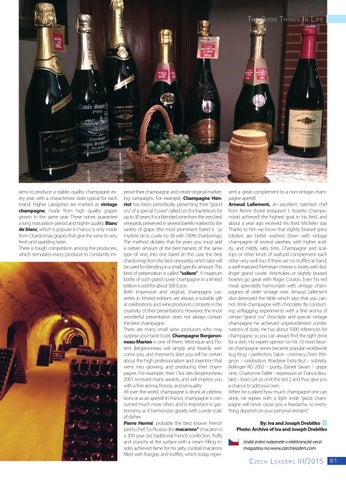T he G ood T hings I n L ife
aims to produce a stable, quality champagne every year, with a characteristic taste typical for each brand. Higher categories are marked as vintage champagne, made from high quality grapes grown in the same year. These wines guarantee a long maturation period and higher quality. Blanc de blanc, which is popular in France, is only made from Chardonnay grapes that give the wine its very fresh and sparkling taste. There is tough competition among the producers, which stimulates every producer to constantly im-
prove their champagne, and create original marketing campaigns. For example, Champagne Henriot has been periodically presenting their “grand cru” of a special “cuvee” called Les Enchanteleurs for up to 30 years. It is a blended wine from the very best vineyards, preserved in several barrels marked by the variety of grape (the most prominent barrel is Le mystére de la cuvée no 38 with 100% chardonnay). The method dictates that for years you must add a certain amount of the best harvest, of the same type of vine, into one barrel (in this case the best chardonnay from the best vineyards), which later will be used for blending in a small, specific amount. This kind of preservation is called “sollera”. A magnum bottle of such grand cuvée champagne in a limited edition is sold for about 500 Euros. Both impressive and original, champagne cassettes in limited editions are always a suitable gift at celebrations, and wine producers compete in the creativity of their presentations. However, the most wonderful presentation does not always contain the best champagne. There are many small wine producers who may surprise your taste buds. Champagne Bergeronneau-Marion is one of them. Véronique and Florent Bergeronneau will simply and heartily welcome you, and moments later you will be certain about the high professionalism and invention that went into growing and producing their champagne. For example, their Clos des Bergeronneau 2007 received many awards, and will impress you with a fine aroma, finesse, and sensuality. All over the world, champagne is drunk at celebrations or as an aperitif. In France, champagne is consumed much more often, and is important in gastronomy, as it harmonizes greatly with a wide scale of dishes. Pierre Hermé, probably the best known French pastry chef, “Le Picasso des macarons” (macaron is a 300 year old traditional French confection, fluffy and crunchy at the surface with a cream filling inside) achieved fame for his salty cocktail macarons filled with foiegras and truffles, which today repre-
sent a great complement to a non-vintage champagne aperitif. Arnaud Lallement, an excellent, talented chef from Reims (hotel restaurant L´Assiette Champenoise) achieved the highest goal in his field, and about a year ago received his third Michelin star. Thanks to him we know that slightly braised spiny lobsters are better washed down with vintage champagne of several varieties, with higher acidity, and mildly salty tints. Champagne and scallops or other kinds of seafood complement each other very well too. If there are no truffles at hand, a well-matured Parmesan cheese is lovely with Bollinger grand cuvée. Artichokes or slightly braised boletes go great with Roger Coulon. Even his red meat splendidly harmonizes with vintage champagnes of older vintage rosé. Arnaud Lallement also destroyed the fable which says that you cannot drink champagne with chocolate. By conducting unflagging experiments with a fine aroma of certain “grand cru” chocolate and special vintage champagne he achieved unprecedented combinations of taste. He has about 5000 references for champagne, so you can always find the right drink for a dish. His expert opinion on his 10 most favorite champagne wines became popular worldwide (e.g. Krug – perfection, Salon – intimacy, Dom Pérignon – celebration, Roederer Extra Brut – sobriety, Bollinger RD 2002 – purity, Daniel Savart – grape vine, Chartonne-Taillet - expression or Francis Boulard – love). Let us omit the last 2 and thus give you a chance to add your own. When he is asked how much champagne one can drink, he replies with a light smile “good champagne will never cause you a headache, so everything depends on your personal restraint.” By: Iva and Joseph Drebitko Photo: Archive of Iva and Joseph Drebitko české znění naleznete v elektronické verzi magazínu na www.czechleaders.com
C zech L eaders III/2015
81
